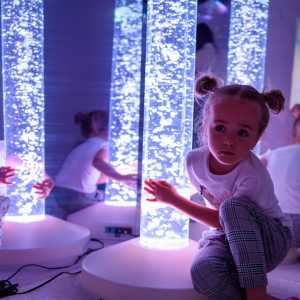Light, often taken for granted in our daily lives, plays a profound role in the sensory experiences of individuals with complex needs, particularly those on the autism spectrum. For these individuals, light can be both a source of comfort and a potential source of distress. Understanding the sensory benefits of lights for those with complex needs, especially autism, is crucial in creating environments that support their well-being and development.
- Regulating Sensory Input:
People with autism often have sensory processing challenges, which means they may experience sensory stimuli more intensely than others. Proper lighting can help regulate these heightened sensory experiences. Soft, diffused lighting can create a calm and soothing atmosphere, reducing the potential for sensory overload. - Visual Clarity:
Good lighting enhances visual clarity, making it easier for individuals with complex needs to process information in their environment. Adequate illumination can help them understand and engage with their surroundings, which is crucial for learning and social interaction. - Establishing Routine and Predictability:
Consistent lighting in daily routines can provide a sense of predictability for individuals with autism. By incorporating lighting cues into schedules, such as bright lighting for daytime and dimmer lighting for bedtime, one can help establish a structured routine that offers comfort and security. - Enhanced Communication:
Lighting can also facilitate non-verbal communication. Individuals with autism may struggle with verbal language, but they often excel in non-verbal communication. Adjusting lighting levels can be a way to convey feelings or intentions, creating an additional channel for expression. - Creating Calm and Safe Spaces:
Properly designed lighting can transform spaces into calming and safe environments. For individuals with complex needs, creating these sensory-friendly spaces is essential for reducing anxiety and promoting relaxation. Warm, soft lighting with minimal flicker can transform a harsh environment into a haven of tranquillity. - Reducing Sensory Overload:
Harsh, fluorescent lighting can be overwhelming for individuals with autism. Such lighting can lead to sensory overload, causing anxiety, irritability, or meltdowns. Soft, adjustable lighting can mitigate this effect, allowing individuals to control and adapt their sensory environment to their needs. - Therapeutic Benefits:
Light therapy, using controlled exposure to specific types of light, has been found to be beneficial for individuals with autism. Some studies suggest that light therapy can help regulate sleep patterns, reduce hyperactivity, and improve mood. It can be a valuable addition to a comprehensive treatment plan. - Promoting Visual Engagement:
Proper lighting can encourage individuals with complex needs, including autism, to engage in various activities. Adequate illumination makes it easier to read, draw, or play, fostering independence and self-expression. - Empowering Independence:
Customisation lighting systems, such as dimmer switches or colour-changing bulbs, can empower individuals to take control of their sensory environment. This not only provides a sense of agency but also helps them adapt to different situations and sensory needs. - Stimulating Sensory Exploration:
Lights, especially those with different colours and textures, can stimulate sensory exploration. This can be particularly beneficial for those with sensory processing difficulties, encouraging them to engage with their environment and develop important sensory skills.
In conclusion, light plays a significant role in the sensory experiences of individuals with complex needs, particularly those with autism. The right lighting can have a profound impact on their comfort, well-being, and development. Understanding and utilising the sensory benefits of lights can help create environments that support their unique needs, providing the foundation for a brighter future.








